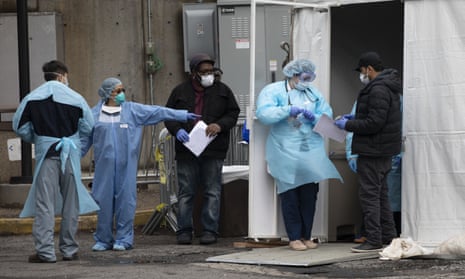Doctors and nurses in New York City hospitals are being advised to continue going to work even if they have had high-risk exposure to a patient with a confirmed case of coronavirus , according to the city’s health department guidelines.
The advice has been met with concern among some medical professionals who fear that the guidelines are helping to foster the spread of the virus in hospitals, including among the most vulnerable patients who may assume that their healthcare providers do not have the potentially lethal virus.
The US Centers for Disease Control (CDC) has said there are reports that the coronavirus can be spread by a person who has the disease but is asymptomatic.
The New York City health department guidelines, which were published on 17 March and are still effective, state that a healthcare worker who has had a “known high-risk exposure to a patient(s) with confirmed COVID-19” should “take extra care to monitor your health but can keep working” and that there is “no requirement for 14 day quarantine of healthcare workers”.
High-risk exposure includes having an unmasked healthcare worker having “prolonged close contact” with an unmasked patient known to be positive and performing various procedures for the patients, including intubation and sputum induction.
These healthcare workers are being asked to “self-monitor” at least twice daily for symptoms, including cough or a temperature of more than 100F, shortness of breath or sore throat, as well as other symptoms including muscle aches, malaise, runny nose, stuffiness or congestion.
“Timing of these checks should be at least 8 hours apart with one check immediately before each healthcare shift,” the guidance states. “If any of these signs/symptoms develop then you MAY NOT come to work.”
Healthcare professionals say the guidance appears to show that New York City hospitals are already in a critical situation. The CDC’s own guidance states that facilities should allow asymptomatic healthcare professionals who have had exposure to work only after “options to improve staffing have been exhausted”.
A spokesperson for the health department confirmed the policy was still in place.
“Based on the information currently available, it is believed that people who are experiencing symptoms are responsible for driving this pandemic,” the spokesperson said in a statement.
The spokesperson added: “We are expecting a substantial surge in patients in New York City’s healthcare system and need to preserve staffing levels to best support those patients.”
One concerned hospital administrator who works at a New York City hospital told the Guardian the policy was putting patients and other staff at risk.
The person cited one example in which a staff member had spent half an hour in close contact with a positive patient without a mask or other protective gear. The person could not be tested because of the scarcity of tests and was told to keep coming to work even though the person was in contact with other patients, including ones with compromised immune systems.
While some hospitals were still following more stringent guidelines and asking exposed staff to stay at home, others have accepted the view that the disease is now so prevalent that isolation is no longer warranted and might lead to severe staffing shortages.
“People are being told, ‘Well, everyone has it,’ when that is really not the case,” the person said.
The response was yet another reason why prioritizing testing for medical professionals ought to be a priority.
A doctor in a New York City hospital said the guidelines probably reflected a fear that the city was nervous it would not have enough medical staff to run hospitals if staff were still being advised to quarantine exposed workers. But the doctor expressed surprise at how quickly guidelines had been changed in his own hospital: from a recommended 14-day quarantine to seven-day quarantine, to now allowing exposed staff to continue working.
Doctors were facing a predicament about whether to accept orders to work, or defy the rules and stay home if they believe they have been exposed.
“I think there are draconian ways the policies are being implemented and it does not seem grounded in theoretical understanding of disease,” the doctor said. “The logic they use is that the situation is ever evolving.”
Esther Choo, an emergency medicine doctor and professor at Oregon Health and Science University, said it was “very telling” that the policy was emerging in New York, which was already facing a crisis.
“First of all, yes, that is very alarming,” said Choo, “It’s not ideal.”
Frontline workers are pointing to the case of Dr Roberto Stella, 67, the Italian physician from Lombardy hailed as a hero for continuing to treat coronavirus patients after protective equipment ran out. He later succumbed to the disease.
“I think that’s what people are deciding right now,” said Choo. “Do I keep going in?”
Dr Roberta Gebhard, president of the American Medical Women’s Association, a professional association of female doctors, said: “As we get stretched, we’re going to drop some of our standard practices … Then we have crisis capacity.
“We have a fixed healthcare workforce, and we start enforcing convention capacity recommendations, we will so rapidly be incapable of meeting basic need,” she said.
